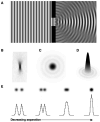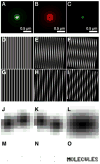Fluorescence microscopy below the diffraction limit
- PMID: 19698798
- PMCID: PMC2784032
- DOI: 10.1016/j.semcdb.2009.08.006
Fluorescence microscopy below the diffraction limit
Abstract
Fluorescence imaging with conventional microscopy has experienced numerous advances in almost every limiting factor from sensitivity to speed. But improved resolution beyond the fundamental limitation of light diffraction has been elusive until recent years. Now, techniques are available that surpass this barrier and improve resolution up to 10 times over that of conventional microscopy. This chapter provides an overview of these new "super-resolution" imaging methods.
Figures


Similar articles
-
Breaking the diffraction barrier: super-resolution imaging of cells.Cell. 2010 Dec 23;143(7):1047-58. doi: 10.1016/j.cell.2010.12.002. Cell. 2010. PMID: 21168201 Free PMC article.
-
Super-resolution fluorescence microscopy.Annu Rev Biochem. 2009;78:993-1016. doi: 10.1146/annurev.biochem.77.061906.092014. Annu Rev Biochem. 2009. PMID: 19489737 Free PMC article. Review.
-
Pushing the super-resolution limit: recent improvements in microscopy below the diffraction limit.Biochem Soc Trans. 2021 Feb 26;49(1):431-439. doi: 10.1042/BST20200746. Biochem Soc Trans. 2021. PMID: 33599719 Review.
-
Recent advances in super-resolution fluorescence imaging and its applications in biology.J Genet Genomics. 2013 Dec 20;40(12):583-95. doi: 10.1016/j.jgg.2013.11.003. Epub 2013 Nov 23. J Genet Genomics. 2013. PMID: 24377865 Review.
-
Cell biology beyond the diffraction limit: near-field scanning optical microscopy.J Cell Sci. 2001 Dec;114(Pt 23):4153-60. doi: 10.1242/jcs.114.23.4153. J Cell Sci. 2001. PMID: 11739648 Review.
Cited by
-
Strategies to overcome the main challenges of the use of exosomes as drug carrier for cancer therapy.Cancer Cell Int. 2022 Oct 18;22(1):323. doi: 10.1186/s12935-022-02743-3. Cancer Cell Int. 2022. PMID: 36258195 Free PMC article. Review.
-
Quantifying spatial organization in point-localization superresolution images using pair correlation analysis.Nat Protoc. 2013 Feb;8(2):345-54. doi: 10.1038/nprot.2013.005. Epub 2013 Jan 24. Nat Protoc. 2013. PMID: 23348362 Free PMC article.
-
Alternative reagents to antibodies in imaging applications.Biophys Rev. 2017 Aug;9(4):299-308. doi: 10.1007/s12551-017-0278-2. Epub 2017 Jul 27. Biophys Rev. 2017. PMID: 28752365 Free PMC article. Review.
-
The power of correlative microscopy: multi-modal, multi-scale, multi-dimensional.Curr Opin Struct Biol. 2011 Oct;21(5):686-93. doi: 10.1016/j.sbi.2011.06.010. Epub 2011 Jul 21. Curr Opin Struct Biol. 2011. PMID: 21782417 Free PMC article.
-
A Comparative Study to Visualize PtdIns(4,5) P2 and PtdIns(3,4,5) P3 in MDA-MB-231 Breast Cancer Cell Line.Rep Biochem Mol Biol. 2022 Jan;10(4):518-526. doi: 10.52547/rbmb.10.4.518. Rep Biochem Mol Biol. 2022. PMID: 35291610 Free PMC article.
References
-
- Ditchburn RW. Light. 1991:42–70.
-
- Gustafsson MG, Agard DA, Sedat JW. I5M: 3D widefield light microscopy with better than 100 nm axial resolution. J Microsc. 1999;195:10–6. - PubMed
-
- Bailey B, et al. Enhancement of axial resolution in fluorescence microscopy by standing-wave excitation. Nature. 1993;366:44–8. - PubMed
-
- Hell SW, Schrader M, van der Voort HT. Far-field fluorescence microscopy with three-dimensional resolution in the 100-nm range. J Microsc. 1997;187:1–7. - PubMed
Publication types
MeSH terms
Grants and funding
LinkOut - more resources
Full Text Sources
Other Literature Sources

